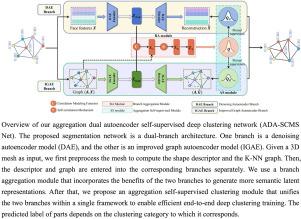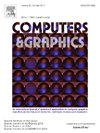ADA-SCMS Net: A self-supervised clustering-based 3D mesh segmentation network with aggregation dual autoencoder
IF 2.8
4区 计算机科学
Q2 COMPUTER SCIENCE, SOFTWARE ENGINEERING
引用次数: 0
Abstract
Despite significant advances in 3D mesh segmentation techniques driven by deep learning, segmenting 3D meshes without exhaustive manual labeling remains a challenging due to difficulties in acquiring high-quality labeled datasets. This paper introduces an aggregation dual autoencoder self-supervised clustering-based mesh segmentation network for unlabeled 3D meshes (ADA-SCMS Net). Expanding upon the previously proposed SCMS-Net, the ADA-SCMS Net enhances the segmentation process by incorporating a denoising autoencoder with an improved graph autoencoder as its basic structure. This modification prompts the segmentation network to concentrate on the primary structure of the input data during training, enabling the capture of robust features. In addition, the ADA-SCMS network introduces two new modules. One module is named the branch aggregation module, which combines the strengths of two branches to create a semantic latent representation. The other is the aggregation self-supervised clustering module, which facilitates end-to-end clustering training by iteratively updating each branch through mutual supervision. Extensive experiments on benchmark datasets validate the effectiveness of the ADA-SCMS network, demonstrating superior segmentation performance compared to the SCMS network.

ADA-SCMS 网络:基于自监督聚类的三维网状分割网络与聚合双自动编码器
尽管深度学习驱动的三维网格分割技术取得了长足进步,但由于难以获得高质量的标记数据集,在不进行详尽人工标记的情况下分割三维网格仍然是一项挑战。本文介绍了一种基于聚合双自动编码器自监督聚类的三维网格分割网络(ADA-SCMS Net)。ADA-SCMS Net 以之前提出的 SCMS-Net 为基础,通过将去噪自动编码器与改进的图自动编码器作为其基本结构,增强了分割过程。这一修改促使分割网络在训练过程中专注于输入数据的主要结构,从而捕捉到稳健的特征。此外,ADA-SCMS 网络还引入了两个新模块。一个模块被命名为分支聚合模块,它结合了两个分支的优势来创建语义潜表征。另一个是聚合自监督聚类模块,它通过相互监督迭代更新每个分支来促进端到端的聚类训练。在基准数据集上进行的大量实验验证了 ADA-SCMS 网络的有效性,与 SCMS 网络相比,ADA-SCMS 网络具有更出色的分割性能。
本文章由计算机程序翻译,如有差异,请以英文原文为准。
求助全文
约1分钟内获得全文
求助全文
来源期刊

Computers & Graphics-Uk
工程技术-计算机:软件工程
CiteScore
5.30
自引率
12.00%
发文量
173
审稿时长
38 days
期刊介绍:
Computers & Graphics is dedicated to disseminate information on research and applications of computer graphics (CG) techniques. The journal encourages articles on:
1. Research and applications of interactive computer graphics. We are particularly interested in novel interaction techniques and applications of CG to problem domains.
2. State-of-the-art papers on late-breaking, cutting-edge research on CG.
3. Information on innovative uses of graphics principles and technologies.
4. Tutorial papers on both teaching CG principles and innovative uses of CG in education.
 求助内容:
求助内容: 应助结果提醒方式:
应助结果提醒方式:


